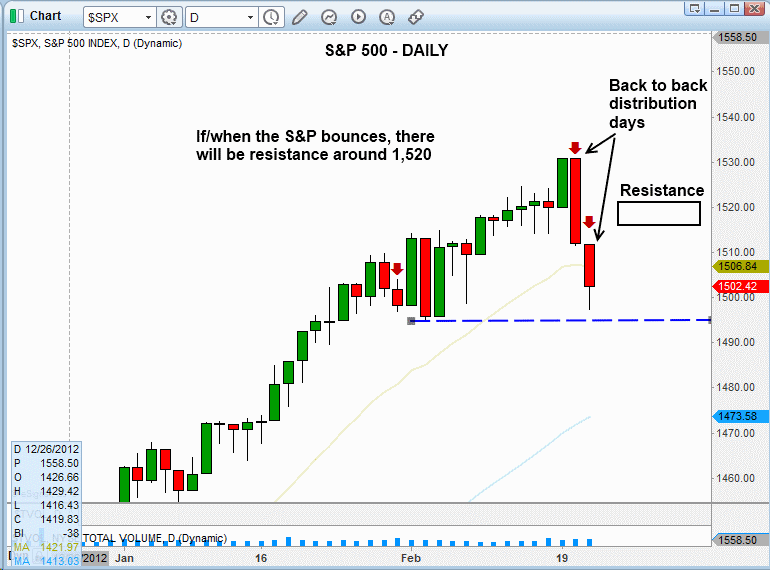| The Wagner Daily ETF Report For February 22 |
| By Deron Wagner |
Published
02/22/2013
|
Stocks
|
Unrated
|
|
|
|
The Wagner Daily ETF Report For February 22
For the second day in a row, the broad market sold off across the board on higher volume. Although the percent losses were not as bad as Wednesday, the S&P 500 followed through to the downside for the first time in 2013. With turnover increasing on the both the Nasdaq and NYSE, the S&P 500 and Nasdaq have posted back to back distribution days. Whenever distribution begins to cluster, we take notice. Although we never care whether or not stocks are "overbought," the increasing presence of institutional selling is indeed one of the most important factors we use when assessing the health of a rally.
Given the sudden reversal in market sentiment over the past two days, this is the perfect time to share with momentum swing traders our top two tips for managing your trading account in a stock market that may be forming a top:
Be sure you know and are on aggressive mental defense against these 4 most dangerous psychological emotions for stock traders (greed, fear, hope, and regret). In particular, given the sharp losses of the past two days, traders absolutely must be on alert for the natural human emotion of paralyzing fear that may prevent you from simply cutting your losses on any losing trades that have already hit your stop prices. To ignore your predetermined stop losses is always tantamount to playing Russian roulette with your trading account. But this is even more so the case right now, as the recent rally is beginning to show valid technical signals of a potential top.
In case you missed most or all of the rally of the past two months, perhaps because you didn't believe in it for whatever reason, you are now probably feeling the pain of regret. If this is the case, you must be very careful to avoid being a "late to the party Charlie" (LTPC) right now. To learn what this means, check out this article we ironically wrote nearly exactly a year ago. While the stock market's current pullback may indeed turn out to be a low-risk buying opportunity, it is dangerous and way too early to make that determination right now. Continue reading to learn why...
As far as the charts of the major averages go, the S&P 500, small-cap Russell 2000, and S&P Midcap 400 appear to be in decent shape. The same can not be said of the Nasdaq Composite, which has taken a beating the past two sessions, and is already closing in on intermediate-term support of its 50-day moving average. The Nasdaq 100 Index, which basically did not budge during the entire rally in the rest of the broad market, is already trading below key support of its 50-day MA.
Looking at the daily chart of the S&P 500 below, it appears the price may be headed for an "undercut" of the prior swing low, around the 1,494 area:

If and when the S&P attempts to bounce from its current level, the subsequent price and volume action that immediately follows any recovery attempt will be extremely important at determining whether stocks are merely take a breather, or if the rally is dead.
Next week's price action in the S&P is important because there is a cluster of technical price resistance around the 1,515 to 1,520 area (annotated by the black rectangle on the chart above). Four sessions of stalling action last week created overhead supply around 1,520, while the 1,515 level represents resistance of a 50% Fibonacci retracement (based on the range from the February 20 high down to the February 21 low).
If the S&P 500 generates another distribution day that follows just a feeble, light volume bounce off the current lows, that could be the nail in the coffin for the current rally. Still, unless leadership stocks suddenly begin breaking down en masse, a pullback to the 50-day moving average of the S&P 500 would be considered normal within the context of the strong rally of the past two months.
As we closely monitor price and volume action of the broad market over the next week, we will gain a much better idea as to the likely direction of the stock market's next major move, which will automatically cause our rule-based stock market timing system (learn more about the system here) to be adjusted accordingly. But in the meantime, be sure to read the two articles mentioned above so that you will be on guard against the most dangerous emotions that could seriously harm your trading account right now, while also avoiding becoming a member of the "late to the party Charlie" club.
Deron Wagner is the Founder and Head Trader of both Morpheus Capital LP, a U.S. hedge fund, and MorpheusTrading.com, a trader education firm.
|